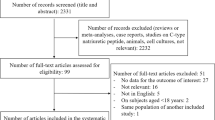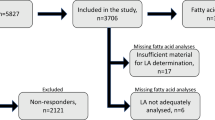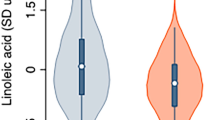Abstract
Background/Objectives:
Cardiovascular (CV) disease is the leading cause of death after renal transplantation. Marine n-3 polyunsaturated fatty acids (PUFAs) exert potential cardio-protective metabolic effects and might reduce CV morbidity and mortality in renal transplant recipients (RTRs).
Subjects/Methods:
In this cross-sectional study of 1990 Norwegian RTRs, transplanted between 1999 and 2011, associations between plasma phospholipid marine n-3 PUFA levels and various CV risk markers at 10 weeks after transplant were evaluated.
Results:
Higher plasma marine n-3 PUFA levels were associated with lower resting heart rate (rHR), lower fasting plasma glucose (fPG) levels, lower plasma triglyceride levels and higher plasma high-density lipoprotein (HDL) cholesterol levels. Plasma levels of eicosapentaenoic acid, but not docosahexaenoic acid, showed a positive association with plasma HDL cholesterol levels. Plasma marine n-3 PUFA levels were not associated with plasma low-density lipoprotein cholesterol levels, pulse wave velocity or systolic and diastolic blood pressure. A negative association between plasma marine n-3 PUFA levels and CV mortality was weakened by additional adjustment for plasma triglyceride levels and rHR. The ratio of n-6 to n-3 PUFAs showed similar associations with CV risk markers as absolute plasma marine n-3 PUFA levels.
Conclusions:
This is the first study in RTRs showing that marine n-3 PUFAs are negatively associated with rHR and fPG in addition to beneficial effects on plasma HDL cholesterol and triglyceride levels. Especially, effects on autonomic nervous function and triglyceride metabolism might contribute to explain the lower CV mortality risk with higher plasma marine n-3 PUFA levels previously shown in this cohort.
This is a preview of subscription content, access via your institution
Access options
Subscribe to this journal
Receive 12 print issues and online access
$259.00 per year
only $21.58 per issue
Buy this article
- Purchase on Springer Link
- Instant access to full article PDF
Prices may be subject to local taxes which are calculated during checkout

Similar content being viewed by others
References
Israni AK, Snyder JJ, Skeans MA, Peng Y, Maclean JR, Weinhandl ED et al. Predicting coronary heart disease after kidney transplantation: Patient Outcomes in Renal Transplantation (PORT) Study. Am J Transplant 2010; 10: 338–353.
Foley RN, Parfrey PS, Sarnak MJ . Clinical epidemiology of cardiovascular disease in chronic renal disease. Am J Kidney Dis 1998; 32 (5 Suppl 3), S112–S119.
Jardine AG, Gaston RS, Fellstrom BC, Holdaas H . Prevention of cardiovascular disease in adult recipients of kidney transplants. Lancet 2011; 378: 1419–1427.
De Caterina R . n-3 fatty acids in cardiovascular disease. N Engl J Med 2011; 364: 2439–2450.
Harris WS, Miller M, Tighe AP, Davidson MH, Schaefer EJ . Omega-3 fatty acids and coronary heart disease risk: clinical and mechanistic perspectives. Atherosclerosis 2008; 197: 12–24.
Bonaa KH, Bjerve KS, Straume B, Gram IT, Thelle D . Effect of eicosapentaenoic and docosahexaenoic acids on blood pressure in hypertension. A population-based intervention trial from the Tromso study. N Engl J Med 1990; 322: 795–801.
Sekikawa A, Miura K, Lee S, Fujiyoshi A, Edmundowicz D, Kadowaki T et al. Long chain n-3 polyunsaturated fatty acids and incidence rate of coronary artery calcification in Japanese men in Japan and white men in the USA: population based prospective cohort study. Heart 2014; 100: 569–573.
Calder PC . n-3 polyunsaturated fatty acids, inflammation, and inflammatory diseases. Am J Clin Nutr 2006; 83 (6 Suppl), 1505s–1519s.
Christensen JH, Gustenhoff P, Korup E, Aaroe J, Toft E, Moller J et al. Effect of fish oil on heart rate variability in survivors of myocardial infarction: a double blind randomised controlled trial. BMJ (Clinical research ed) 1996; 312: 677–678.
Eritsland J, Arnesen H, Seljeflot I, Kierulf P . Long-term effects of n-3 polyunsaturated fatty acids on haemostatic variables and bleeding episodes in patients with coronary artery disease. Blood Coagul Fibrinolysis 1995; 6: 17–22.
Kwak SM, Myung SK, Lee YJ, Seo HG . Efficacy of omega-3 fatty acid supplements (eicosapentaenoic acid and docosahexaenoic acid) in the secondary prevention of cardiovascular disease: a meta-analysis of randomized, double-blind, placebo-controlled trials. Arch Intern Med 2012; 172: 686–694.
Lim AK, Manley KJ, Roberts MA, Fraenkel MB . Fish oil treatment for kidney transplant recipients: a meta-analysis of randomized controlled trials. Transplantation 2007; 83: 831–838.
Tatsioni A, Chung M, Sun Y, Kupelnick B, Lichtenstein AH, Perrone R et al. Effects of fish oil supplementation on kidney transplantation: a systematic review and meta-analysis of randomized, controlled trials. J Am Soc Nephrol 2005; 16: 2462–2470.
Bonis PA, Chung M, Tatsioni A, Sun Y, Kupelnick B, Lichtenstein A et al. Effects of omega-3 fatty acids on organ transplantation. Evid Rep Technol Assess (Summ) 2005; 115: 1–11.
Filler G, Weiglein G, Gharib MT, Casier S . Omega3 fatty acids may reduce hyperlipidemia in pediatric renal transplant recipients. Pediatr Transplant 2012; 16: 835–839.
Eide IA, Jenssen T, Hartmann A, Diep LM, Dahle DO, Reisaeter AV et al. The association between marine n-3 polyunsaturated fatty acid levels and survival after renal transplantation. Clin J Am Soc Nephrol 2015; 10: 1246–1256.
Dahle DO, Eide IA, Asberg A, Leivestad T, Holdaas H, Jenssen TG et al. Aortic stiffness in a mortality risk calculator for kidney transplant recipients. Transplantation 2015; 99: 1730–1737.
Levey AS, Coresh J, Greene T, Stevens LA, Zhang YL, Hendriksen S et al. Using standardized serum creatinine values in the modification of diet in renal disease study equation for estimating glomerular filtration rate. Ann Intern Med 2006; 145: 247–254.
Pei J, Zhao Y, Huang L, Zhang X, Wu Y . The effect of n-3 polyunsaturated fatty acids on plasma lipids and lipoproteins in patients with chronic renal failure—a meta-analysis of randomized controlled trials. J Ren Nutr 2012; 22: 525–532.
Yokoyama M, Origasa H, Matsuzaki M, Matsuzawa Y, Saito Y, Ishikawa Y et al. Effects of eicosapentaenoic acid on major coronary events in hypercholesterolaemic patients (JELIS): a randomised open-label, blinded endpoint analysis. Lancet 2007; 369: 1090–1098.
Rubies-Prat J, Espinel E, Joven J, Ras MR, Pira L . High-density lipoprotein cholesterol subfractions in chronic uremia. Am J Kidney Dis 1987; 9: 60–65.
Bonaa KH, Bjerve KS, Nordoy A . Habitual fish consumption, plasma phospholipid fatty acids, and serum lipids: the Tromso study. Am J Clin Nutr 1992; 55: 1126–1134.
Jacobson TA, Glickstein SB, Rowe JD, Soni PN . Effects of eicosapentaenoic acid and docosahexaenoic acid on low-density lipoprotein cholesterol and other lipids: a review. J Clin Lipidol 2012; 6: 5–18.
Wu JH, Micha R, Imamura F, Pan A, Biggs ML, Ajaz O et al. Omega-3 fatty acids and incident type 2 diabetes: a systematic review and meta-analysis. Br J Nutr 2012; 107 (Suppl 2), S214–S227.
Patel PS, Forouhi NG, Kuijsten A, Schulze MB, van Woudenbergh GJ, Ardanaz E et al. The prospective association between total and type of fish intake and type 2 diabetes in 8 European countries: EPIC-InterAct Study. Am J Clin Nutr 2012; 95: 1445–1453.
Kaushik M, Mozaffarian D, Spiegelman D, Manson JE, Willett WC, Hu FB . Long-chain omega-3 fatty acids, fish intake, and the risk of type 2 diabetes mellitus. Am J Clin Nutr 2009; 90: 613–620.
Nanri A, Mizoue T, Noda M, Takahashi Y, Matsushita Y, Poudel-Tandukar K et al. Fish intake and type 2 diabetes in Japanese men and women: the Japan Public Health Center-based Prospective Study. Am J Clin Nutr 2011; 94: 884–891.
Villegas R, Xiang YB, Elasy T, Li HL, Yang G, Cai H et al. Fish, shellfish, and long-chain n-3 fatty acid consumption and risk of incident type 2 diabetes in middle-aged Chinese men and women. Am J Clin Nutr 2011; 94: 543–551.
Mozaffarian D, Lemaitre RN, King IB, Song X, Spiegelman D, Sachs FM et al. Circulating long-chain omega-3 fatty acids and incidence of congestive heart failure in older adults: the cardiovascular health study: a cohort study. Ann Intern Med 2011; 155: 160–170.
Weeratunga P, Jayasinghe S, Perera Y, Jayasena G, Jayasinghe S . Per capita sugar consumption and prevalence of diabetes mellitus—global and regional associations. BMC Public Health 2014; 14: 186.
Virtanen JK, Mursu J, Voutilainen S, Uusitupa M, Tuomainen TP . Serum omega-3 polyunsaturated fatty acids and risk of incident type 2 diabetes in men: the Kuopio Ischemic Heart Disease Risk Factor Study. Diabetes Care 2014; 37: 189–196.
Gerich JE . Metabolic abnormalities in impaired glucose tolerance. Metabolism 1997; 46 (12 Suppl 1), 40–43.
Consoli A . Role of liver in pathophysiology of NIDDM. Diabetes Care 1992; 15: 430–441.
Balk EM, Lichtenstein AH, Chung M, Kupelnick B, Chew P, Lau J . Effects of omega-3 fatty acids on serum markers of cardiovascular disease risk: a systematic review. Atherosclerosis 2006; 189: 19–30.
Bosch J, Gerstein HC, Dagenais GR, Diaz R, Dyal L, Jung H et al. n-3 fatty acids and cardiovascular outcomes in patients with dysglycemia. N Engl J Med 2012; 367: 309–318.
Su HY, Lee HC, Cheng WY, Huang SY . A calorie-restriction diet supplemented with fish oil and high-protein powder is associated with reduced severity of metabolic syndrome in obese women. Eur J Clin Nutr 2015; 69: 322–328.
Giacco R, Cuomo V, Vessby B, Uusitupa M, Hermansen K, Meyer BJ et al. Fish oil, insulin sensitivity, insulin secretion and glucose tolerance in healthy people: is there any effect of fish oil supplementation in relation to the type of background diet and habitual dietary intake of n-6 and n-3 fatty acids? Nutr Metab Cardiovasc Dis 2007; 17: 572–580.
Albert BB, Derraik JG, Brennan CM, Biggs JB, Garg ML, Cameron-Smith D et al. Supplementation with a blend of krill and salmon oil is associated with increased metabolic risk in overweight men. Am J Clin Nutr 2015; 102: 49–57.
Harris WS, Gonzales M, Laney N, Sastre A, Borkon AM . Effects of omega-3 fatty acids on heart rate in cardiac transplant recipients. Am J Cardiol 2006; 98: 1393–1395.
Friedman AN, Yu Z, Tabbey R, Denski C, Tamez H, Wenger J et al. Inverse relationship between long-chain n-3 fatty acids and risk of sudden cardiac death in patients starting hemodialysis. Kidney Int 2013; 83: 1130–1135.
Yildiz A, Sever MS, Demirel S, Akkaya V, Turk S, Turkmen A et al. Improvement of uremic autonomic dysfunction after renal transplantation: a heart rate variability study. Nephron 1998; 80: 57–60.
Iso H, Kobayashi M, Ishihara J, Sasaki S, Okada K, Kita Y et al. Intake of fish and n3 fatty acids and risk of coronary heart disease among Japanese: the Japan Public Health Center-Based (JPHC) Study Cohort I. Circulation 2006; 113: 195–202.
GISSI-Prevenzione Investigators. Dietary supplementation with n-3 polyunsaturated fatty acids and vitamin E after myocardial infarction: results of the GISSI-Prevenzione trial. Gruppo Italiano per lo Studio della Sopravvivenza nell'Infarto miocardico. Lancet 1999; 354: 447–455.
Geleijnse JM, Giltay EJ, Grobbee DE, Donders AR, Kok FJ . Blood pressure response to fish oil supplementation: metaregression analysis of randomized trials. J Hypertens 2002; 20: 1493–1499.
Pase MP, Grima NA, Sarris J . The effects of dietary and nutrient interventions on arterial stiffness: a systematic review. Am J Clin Nutr 2011; 93: 446–454.
Sanders TA, Hall WL, Maniou Z, Lewis F, Seed PT, Chowienczyk PJ . Effect of low doses of long-chain n-3 PUFAs on endothelial function and arterial stiffness: a randomized controlled trial. Am J Clin Nutr 2011; 94: 973–980.
Baia LC, Van den Berg E, Vervloet MG, Heilberg IP, Navis G, Bakker SJ et al. Fish and omega-3 fatty acid intake in relation to circulating fibroblast growth factor 23 levels in renal transplant recipients. Nutr Metab Cardiovasc Dis 2014; 24: 1310–1316.
Baia LC, Humalda JK, Vervloet MG, Navis G, Bakker SJ, de Borst MH . Fibroblast growth factor 23 and cardiovascular mortality after kidney transplantation. Clin J Am Soc Nephrol 2013; 8: 1968–1978.
Lindberg M, Midthjell K, Bjerve KS . Long-term tracking of plasma phospholipid fatty acid concentrations and their correlation with the dietary intake of marine foods in newly diagnosed diabetic patients: results from a follow-up of the HUNT Study, Norway. Br J Nutr 2013; 109: 1123–1134.
Huang X, Sjogren P, Cederholm T, Arnlov J, Lindholm B, Riserus U et al. Serum and adipose tissue fatty acid composition as biomarkers of habitual dietary fat intake in elderly men with chronic kidney disease. Nephrol Dial Transplant 2014; 29: 128–136.
Acknowledgements
We thank coworkers Rikke Bülow Eschen, Annette Andreassen, Birthe H Thomsen and Inge Aardestrup at The Lipid Research Laboratory, Aalborg University Hospital, Denmark, for analyzing plasma phospholipid fatty acids and Dr Stein Bergan at Oslo University Hospital, Rikshospitalet, Norway, for laboratory analyzes. We thank Dr Torbjørn Leivestad at The Norwegian Renal Registry, Oslo University Hospital, Rikshospitalet, for provision of data. Finally, we also thank the study participants and the funding sources South-Eastern Norway Regional Health Authority, Gidske and Peter Jacob Sørensen Research Fund, The Norwegian National Association for Kidney Patients and Transplant Recipients Research Fund, Nathalia and Knut Juul Christensen Research Fund, Signe and Albert Bergsmarken Research Fund, The Raagholt Foundation, The Freia Corporation Medical Fund and Gertrude and Jack Nelsons Research Fund for their support. IAE and DOD received research funding from South-Eastern Norway Regional Health Authority. IAE received additional funding from Gidske and Peter Jacob Sørensen Research Fund, The Norwegian National Association for Kidney Patients and Transplant Recipients Research Fund, Nathalia and Knut Juul Christensen Research Fund, Signe and Albert Bergsmarken Research Fund, The Raagholt Foundation, The Freia Corporation Medical Fund and Gertrude and Jack Nelsons Research Fund. The funding organizations had no role in the design of the study, data collection, data analysis, interpretation, manuscript preparation or the decision to submit.
Author contributions
Concept and design: MS, TJ, AH, JHC and IAE. Provision of study patients: TJ, AÅ and AH. Collection and assembly of data: MEL, KL, DOD, AH, TJ, AÅ and IAE. Fatty acid analysis: EBS. Data analysis and interpretation: DOD and IAE. Administrative, technical and logistic support: MS, TJ, AÅ, AH and EBS. Drafting of article: IAE. Critical revision of the article: DOD, MS, KSB, JHC, EBS, AÅ, KL, MEL, AH and TJ. Final approval of manuscript: IAE, DOD, KSB, MS, JHC, EBS, AÅ, MEL, KL, AH and TJ.
Author information
Authors and Affiliations
Corresponding author
Ethics declarations
Competing interests
The authors declare no conflict of interest.
Additional information
Supplementary Information accompanies this paper on European Journal of Clinical Nutrition website
Supplementary information
Rights and permissions
About this article
Cite this article
Eide, I., Dahle, D., Svensson, M. et al. Plasma levels of marine n-3 fatty acids and cardiovascular risk markers in renal transplant recipients. Eur J Clin Nutr 70, 824–830 (2016). https://doi.org/10.1038/ejcn.2016.14
Received:
Revised:
Accepted:
Published:
Issue Date:
DOI: https://doi.org/10.1038/ejcn.2016.14



